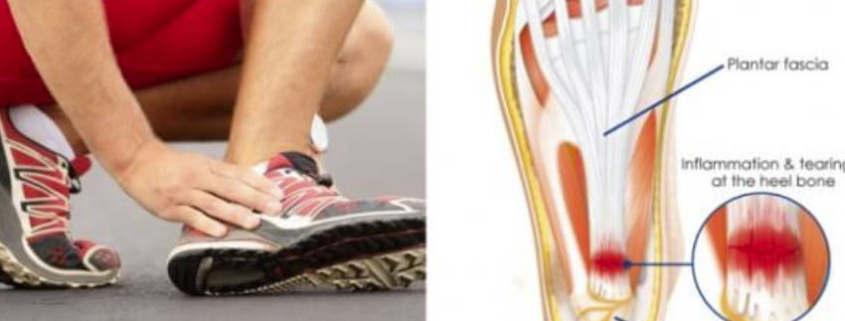Plantar Fasciitis
The arch of the foot functions like a bow (as in a bow and arrow), and the plantar fascia is like the string of the bow. The tension in the “bow string” holds the shape of the arch. But every time you step, the “bow string” stretches. and when stretched too hard and too often, it gets irritated, and then it’s like a bow shooting you in the foot!" Anon Plantar fasciitis sufferers feel a sharp stab or deep ache and stiffness on the bottom of the foot especially near the inside edge or center of the heel and along the inside arch in the mid-foot area.
Symptoms develop gradually over time. It usually affects just one foot, but it can affect both feet.Fascia is found throughout the body enveloping and linking muscles, bones and organs. In the foot it is a very tough tissue which runs from the heel to the bones in the middle of the foot and acts as a shockabsorber, whilst supporting the arch of the foot in locomotion. This fascia continues to the calf muscles and hamstrings. Commonly the pain that is worse upon getting out of bed in the morning. Taking that first step may cause a sudden strain on the bottom of the foot. The pain can recur after long spells of sitting, but it tends to fade during exercise, once the area is warmed up.
Plantar fasciitis can be caused by biomechanical flaws, including tight Achilles tendon, flat feet, high-arched feet; excessive foot pronation; sudden increases in exercise speed, intensity and frequency; wearinginappropriate exercise shoes; exercising on hard surfaces, or wearing high heels all day before switching into flat exercise shoes. and with wearing non supportive shoes or sandals, e.g. flip flops, sandals andhigh heeled shoes.
People who are on their feet for long periods of time (athletes, nurses, fire, military personnel, waitresses etc.) are more likely to suffer from plantar fasciitis.
The stress of overuse, over-pronation, or overused shoes can cause wear and tear and degenerative changes on the fascia (plantar fasciosis), causing pain and inflammation.
Plantar fasciitis is poor biomechanical control over the foot/ankle, arch and toes during movement walking, running, exercise which can cause abnormal stress to tissues not conditioned to take the forces applied.People develop their biomechanics during childhood and adolescence, with lifestyle based factors or from repetitive postures and positions assumed. Bad mechanics can be local (foot/ankle/toes) or further away(knee/hip/pelvis/spine). Osteopaths understand how to assess and correct bad mechanics.
Osteopathic treatment focuses on understanding the development of plantar fasciitis rather than just treating the plantar fasciitis. Patients with mechanical problems of the hip, knee, pelvis, spine can end up with plantar fasciitis. Poor foot biomechanics often play a significant role in the cause of plantar fasciitis so it is vital to thoroughly assess and correct foot and leg biomechanics to prevent future plantar fasciitis episodes. Your osteopath is trained in assessment of the musculoskeletal system which includes the feet.Osteopathic treatment offers a dynamic biomechanical hands on approach.They may recommend that you seek prescription of foot orthotics.
View a list of common complains that Osteopathy can assist with
Discovery the benefits of Osteopathy
- What is Osteopathy?
- Adult health issues
- Babies and Children
- During and after pregnancy
- Common Complaints
- Testimonials
- Sports Injuries
- Genral Osteopathy FAQs
- The Science & Reasearch



